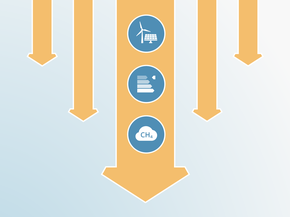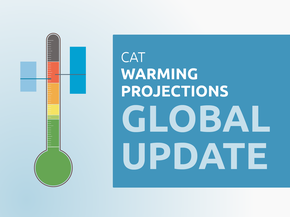Assumptions
Historical emissions
Historical emissions from 1990 to 2022 are taken from PRIMAP National Greenhouse Gas Emission Database 2023 (Gütschow et al., 2025). Saudi Arabia’s own national inventory data from the UNFCCC only extends to 2012.
LULUCF values for 1990, 2000, 2010, and 2012 are still taken from the UNFCCC emissions inventory (2018).
NDC and other targets
2021 NDC
As Saudi Arabia has not communicated the business as usual (BAU) scenario for its NDC target, we quantified the target based on a business-as-usual scenario developed by the King Abdullah Petroleum Studies and Research Center (KAPSARC). The lower end of the NDC range reflects the KAPSARC BAU scenario, excluding land use, land use change and forestry (LULUCF). For the upper end of the range, we have assumed that LULUCF measures would contribute 200 MtCO2e of the total 278 MtCO2e emissions reductions in the NDC. This figure is based on announcements made at the Saudi Green Initiative Forum in 2021 (Kingdom of Saudi Arabia, 2021a). In 2012, the latest year for which national data is available, the land use and forestry sink stood at just 9 MtCO2e, with forests covering a mere 0.5% of Saudi Arabia’s total land area in 2021.
It has come to our attention that the BAU scenario developed by KAPSARC is no longer publicly available online. For this update, we have continued to rely on the previously accessible data. We will consider using an alternative scenario in our next update, or once Saudi Arabia publishes its new 2035 NDC target.
The Global Warming Potential (GWP) values used for the NDC have not been communicated. We have assumed these to be expressed in either AR5 or SAR and have included both calculations in our range.
Current policy projections
Our current policy projections (CPP) for Saudi Arabia are presented as a range (CPP min & CPP max) to reflect the uncertainty around the pace of renewable energy deployment in the power sector. As the foundation, we draw on the "no policy scenario" developed in this study published by KAPSARC in November 2023 (Kamboj et al., 2023).
Upper end of current policy projections
In the study, KAPSARC provides both a "no policy scenario" and a "current policy scenario." We chose not to use the "current policy scenario," as it assumes Saudi Arabia will achieve its target of generating 50% of electricity from renewables by 2030. Given that renewables accounted for only 2% of electricity generation in 2024, we consider this assumption highly unrealistic and not reflective of actual policy implementation. Instead, we based our CPP on the "no policy scenario," which we find more consistent with current developments: slow progress on renewable deployment and the absence of substantial mitigation measures in other sectors.
This scenario assumes the following:
- No energy efficiency gains in the building and transport sectors;
- No energy price reforms, i.e., subsidized fuel prices continue;
- No climate mitigation policy, i.e., no NDC target;
- No market/support for low-carbon technologies;
- 12 TWh of electricity generated by renewables in 2030 (3% of total generation).
For the upper end of the CPP, we apply the growth rates from the KAPSARC’s "no policy scenario" and harmonise them to the latest historical year provided in the PRIMAP dataset.
Lower end of current policy projections
To reflect the potential but limited progress on renewables, we apply the same approach used for CPP's upper end, but adjust emissions from the power sector to reflect a faster deployment of renewables. For this CPP min scenario, we incorporate an assessment from International Energy Agency (IEA), which projects renewables could reach around 14% of electricity generation by 2030. We keep the same assumptions as in the "no policy scenario," except we assume an increase in RE generation. Specifically:
- We assume RE is 14% of total generation in 2030 and extrapolate until 2035 using 5-year trend. This is based on projections by the IEA (IEA, 2025b).
- We assume the total demand follows the "no policy scenario" projections.
We assume the increase in renewables does not have any impact on emissions beyond the power sector.
Planned policy projections
Our planned policy scenario is based on KAPSARC’s "current policy scenario" (Kamboj et al., 2023), which includes the following assumptions:
- Energy efficiency gains are reflected based on various initiatives by SEEC in the end use sectors.
- Reflects energy price reforms by calibrating the 2020 fuel prices in the model to the actual fuel prices in Saudi Arabia after two rounds of price reforms in 2016 and 2018.
- Equal electricity generation capacity of renewable and gas-based plants by 2030.
We apply the growth rates from the KAPSARC’s "no policy scenario" until 2030 and harmonise them to the latest historical year provided in the PRIMAP-hist dataset. We extrapolate until 2035 using 5-year trend.
Net-zero target and other long-term targets
The Saudi government has announced it aims to achieve a sink of 200 MtCO2 from 2030 onwards, which we assume to stay constant towards 2060 to meet Saudi Arabia’s net zero CO2 target.
Given the lack of information on Saudi Arabia’s net zero target announcement, we have assume it aims to reach net zero CO2 emissions by 2060.
We assume that CO2 emissions will decline at a linear rate between 2030 and 2060 to balance LULUCF sinks in 2060. We further assume that non-CO2 emissions will decline at a linear rate between 2030 and 2080 in line with the IPCC SR1.5 pathways.
Global Warming Potentials values
The CAT uses Global Warming Potential (GWP) values from the IPCC's Fifth Assessment Report (AR5) for all its figures and time series.
Further analysis
Latest publications
Stay informed
Subscribe to our newsletter




